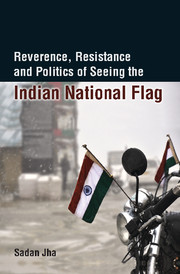Book contents
- Frontmatter
- Contents
- List of Figures
- Preface
- Acknowledgements
- Introduction
- 1 Rise of the Flag
- 2 Flag on the Hut: Totem and a Political Symbol
- 3 The Indian National Flag as a Site of Daily Plebiscite
- 4 Shades of History: A Case of Saffron Colour
- 5 Visualizing an Ideal Political Order
- 6 A Post-Colonial Symbol
- 7 Gendered Symbol, Communal Politics
- Epilogue The Flag as a Sacred Political Symbol
- Bibliography
- Index
6 - A Post-Colonial Symbol
Published online by Cambridge University Press: 18 December 2015
- Frontmatter
- Contents
- List of Figures
- Preface
- Acknowledgements
- Introduction
- 1 Rise of the Flag
- 2 Flag on the Hut: Totem and a Political Symbol
- 3 The Indian National Flag as a Site of Daily Plebiscite
- 4 Shades of History: A Case of Saffron Colour
- 5 Visualizing an Ideal Political Order
- 6 A Post-Colonial Symbol
- 7 Gendered Symbol, Communal Politics
- Epilogue The Flag as a Sacred Political Symbol
- Bibliography
- Index
Summary
Impression
Whoever in any public place or in any other place within public view burns, mutilates, defaces, defiles, disfigures, destroys, tramples upon or otherwise shows disrespect to or brings into contempt (whether by words, either spoken or written, or by acts) the Indian National Flag…or any part thereof, shall be punished with imprisonment for a term which may extend to three years, or with fine, or with both….
Explanation 2.---The expression, ‘Indian National Flag’ includes any picture, painting, drawing or photograph, or other visible representation of the Indian National Flag, or any part or parts thereof, made of any substance or represented on any substance.
Introduction
In the last chapter, we witnessed competing claims of the modern statecraft and tendencies that aspired to keep alive multiplicity of the form of this symbol, its meanings and memories of resistance against colonial state, i.e. a symbol of popular resistance against the state. The attempts to erase community ties (colours acquiring non-sectarian connotations) and its survival in the name of history (arrival of Ashokan wheel from Buddhist religious tradition) leads us to two different trajectories.
Firstly, this conflict takes us to voices of resistance and protest against the new flag that surfaced against the decision of the Flag committee outside the premise of the Constituent Assembly. Different political groups also raised their voice but were largely helpless or their concerns remained un-attended due to the composition of the Constituent Assembly. The removal of the Gandhian Charkha was lauded by Veer Damodar Savarkar (probably the most influential ideologue of Hindu nationalism at that time) who said that this move had made the new flag ‘much less objectionable’. Yet, he refused to recognize the new flag as the national flag of Hindusthan on the ground that the state of Indian Union and the Constituent Assembly were creations of the British will and not by the free choice of people through a national plebiscite. He advocated no flag ‘other than the Bhagwā with the Kundalini and the Kirpān inscribed on it’ for the country. Savarkar and the Maharashtra lobby of Hindu nationalists tried hard to pursue the case of the Bhagwā flag.
- Type
- Chapter
- Information
- Publisher: Cambridge University PressPrint publication year: 2016



